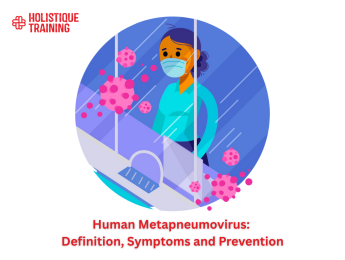- Table of Contents
- Introduction
- What is Human Metapneumovirus (HMPV)?
- Is HMPV Just a Cold?
- HMPV & RSV: What are the Differences?
- How Common is HMPV?
- What are the Symptoms of HMPV?
- 1. Upper Respiratory Symptoms
- 2. Fever
- 3. Lower Respiratory Symptoms
- 4. Fatigue and Malaise
- 5. Duration of Symptoms
- 6. Potential Complications
- How Does HMPV Spread?
- 1. Respiratory Droplet Transmission
- 2. Surface Contamination and Fomite Transmission
- 3. Aerosol Transmission
- 4. Direct Contact Transmission
- 5. Seasonal and Environmental Factors
- 6. Vulnerability of Certain Populations
- Prevention of HMPV
- 1. CDC Isolation Precaution Guidelines
- 2. Vaccination and Immunization
- 3. Promoting Good Respiratory Hygiene
- 4. Environmental Cleaning and Disinfection
- 5. Avoiding Crowded and Poorly Ventilated Spaces
- 6. Education and Awareness
- 7. Healthy Lifestyle Choices
- Testing and Diagnosis of HMPV
- Treatment of HMPV
- Conclusion
Introduction
Human Metapneumovirus (HMPV) is a lesser-known but significant pathogen that can lead to respiratory illnesses, particularly in vulnerable populations. This blog post will explore the intricacies of HMPV, including its symptoms, transmission, and how it differs from other respiratory viruses like Respiratory Syncytial Virus (RSV). By delving into the prevalence, diagnosis, and treatment options for HMPV, we aim to provide a comprehensive understanding of this virus and the impact it has on public health.
What is Human Metapneumovirus (HMPV)?
Human Metapneumovirus is an enveloped RNA virus that belongs to the Paramyxoviridae family. Discovered in 2001, HMPV was identified as a significant contributor to respiratory infections, particularly in young children, the elderly, and immunocompromised individuals. The virus is characterized by its ability to cause a range of respiratory illnesses, from mild cold-like symptoms to severe pneumonia.
HMPV is classified into two main genetic groups: A and B, with further subtypes identified within each group. The virus primarily infects the upper and lower respiratory tracts, leading to inflammation and respiratory distress. It is important to note that HMPV is not the same as the more commonly known viruses that cause seasonal flu or common colds, even though it can produce similar symptoms.
Is HMPV Just a Cold?
While HMPV can result in symptoms akin to those of a common cold, it is not merely a cold. The virus can lead to more severe respiratory conditions, particularly in high-risk groups. Symptoms of HMPV infection may include:
- Cough
- Fever
- Nasal congestion
- Sore throat
- Wheezing
- Difficulty breathing
In healthy adults, HMPV often presents as a mild illness resembling a cold or flu. However, in infants, older adults, and individuals with pre-existing health conditions, HMPV can lead to more serious complications, such as bronchiolitis or pneumonia. Thus, while it can manifest as a simple cold, HMPV has the potential to cause significant respiratory distress in vulnerable populations.
HMPV & RSV: What are the Differences?
HMPV and Respiratory Syncytial Virus (RSV) are both members of the Paramyxoviridae family and are known to cause similar respiratory illnesses. However, there are key differences between the two viruses:
- Epidemiology: RSV is more prevalent and is often associated with seasonal outbreaks, particularly in winter months. HMPV, on the other hand, has a less predictable seasonal pattern and can circulate throughout the year. However, data from the CDC's National Respiratory and Enteric Virus Surveillance System (NREVSS) indicates that HMPV exhibits peak activity during late winter and spring in temperate regions, highlighting its tendency to be more active during these specific times.
- Demographics: While both viruses primarily affect young children, RSV is particularly notorious for causing severe illness in infants under one year of age. HMPV, while also impacting children, has a broader range of affected age groups, including older adults.
- Clinical Presentation: Both viruses can cause similar symptoms, but RSV is more frequently associated with severe lower respiratory tract infections, such as bronchiolitis. HMPV can cause similar issues but is generally less severe in children.
- Diagnosis: Diagnostic methods for RSV and HMPV are similar, but specific tests can differentiate between the two. Rapid antigen tests and PCR assays are commonly used to identify the virus responsible for respiratory illness.
Here’s a table that summarizes the differences between Human Metapneumovirus (HMPV) and Respiratory Syncytial Virus (RSV):
Characteristic | HMPV | RSV |
Epidemiology | Less predictable seasonal pattern; can circulate year-round | Seasonal outbreaks, primarily in winter months |
Demographics | Affects all age groups, especially young children and older adults | Primarily affects infants and young children, particularly under 1 year |
Clinical Presentation | Can cause mild to moderate respiratory illness; may lead to pneumonia in severe cases | Frequently associated with severe lower respiratory tract infections, such as bronchiolitis |
Diagnosis | Diagnosed using PCR and rapid antigen tests; often underdiagnosed | Similar diagnostic methods; widely recognized and tested for in clinical settings |
Treatment Options | Supportive care; no specific antiviral treatment available | Supportive care; some high-risk patients may receive monoclonal antibodies for prevention |
Understanding these differences is crucial for healthcare providers when diagnosing and managing respiratory infections, as the treatment and potential complications may vary between HMPV and RSV.
How Common is HMPV?
HMPV is a globally distributed virus, and studies indicate that it is one of the leading causes of viral respiratory infections, especially in children. Epidemiological data suggest that HMPV infections occur in approximately 5-10% of children hospitalized for respiratory illnesses. The prevalence of HMPV can vary by region and season, with peaks often observed in the spring and fall months.
Despite being a common cause of respiratory infections, HMPV is frequently underdiagnosed due to its similarity to other respiratory viruses. Many cases may go unreported or misclassified as other viral infections, leading to an underestimation of its true prevalence. Increased awareness among healthcare professionals and improved diagnostic techniques are essential for accurately identifying and managing HMPV infections.
What are the Symptoms of HMPV?
The symptoms of Human Metapneumovirus (HMPV) can vary significantly depending on the age and health status of the individual infected. While many healthy adults may experience mild symptoms similar to those of a common cold, infants, older adults, and individuals with compromised immune systems may experience more severe respiratory issues. Here’s a look at the symptoms associated with HMPV:
1. Upper Respiratory Symptoms
HMPV often begins with upper respiratory symptoms, which can include:
- Cough: A persistent cough is one of the hallmark symptoms of HMPV. It may start as dry and later become productive, producing mucus.
- Nasal Congestion: Individuals may experience a runny or stuffy nose, leading to discomfort and difficulty breathing through the nose.
- Sore Throat: Inflammation in the throat can cause pain and discomfort, making swallowing difficult.
- Sneezing: Frequent sneezing can occur as the body attempts to clear the nasal passages.
These symptoms typically mimic those of a common cold and may last for several days.
2. Fever
Fever is a common symptom of HMPV, although its severity can vary:
- Mild to Moderate Fever: Many individuals may experience a low-grade fever, typically ranging from 100°F to 102°F (37.8°C to 38.9°C).
- Duration: The fever usually lasts for a few days and may accompany other symptoms, indicating the body’s immune response to the viral infection.
3. Lower Respiratory Symptoms
In more severe cases, particularly in high-risk groups, HMPV can lead to lower respiratory tract symptoms, such as:
- Wheezing: This high-pitched whistling sound during breathing is caused by narrowed airways and can indicate bronchial inflammation.
- Shortness of Breath: Individuals may experience difficulty breathing or a feeling of tightness in the chest, particularly during physical activity or when lying down.
- Chest Pain or Discomfort: Some patients report a sensation of pressure or pain in the chest, especially when coughing or taking deep breaths.
These lower respiratory symptoms can be particularly concerning in infants and the elderly, as they may lead to conditions like bronchiolitis or pneumonia.
4. Fatigue and Malaise
General fatigue and a feeling of malaise are common during HMPV infections:
- Lethargy: Many individuals report feeling unusually tired and lacking energy, which can be exacerbated by fever and other symptoms.
- Impact on Daily Activities: This fatigue can hinder daily activities and may require individuals to take time off from work or school to recover.
5. Duration of Symptoms
The duration of symptoms can vary widely:
- Mild Cases: In healthy adults, symptoms may resolve within a week or so, resembling a typical cold.
- Severe Cases: In infants, older adults, or those with underlying health conditions, symptoms may persist for a longer duration, sometimes lasting several weeks.
6. Potential Complications
While most cases of HMPV resolve without complications, certain populations are at higher risk for severe outcomes:
- Infants and Young Children: These individuals may develop bronchiolitis or pneumonia, requiring hospitalization and supportive care.
- Older Adults: Those over 65, especially with pre-existing respiratory conditions, may experience exacerbations of chronic illnesses, leading to increased morbidity.
- Immunocompromised Individuals: Patients with weakened immune systems may face prolonged illness and a higher risk of secondary infections.
Recognizing the symptoms of HMPV is crucial for early diagnosis and management, especially in vulnerable populations. While many individuals may experience mild symptoms, the potential for severe respiratory illness in high-risk groups underscores the importance of awareness and preventive measures. Understanding these symptoms can help individuals seek timely medical attention and reduce the spread of HMPV within communities.
How Does HMPV Spread?
Understanding how Human Metapneumovirus (HMPV) spreads is essential for implementing effective prevention strategies. HMPV is primarily transmitted through respiratory droplets, but its spread can occur in several ways. Here’s a detailed exploration of the transmission routes and contributing factors:
1. Respiratory Droplet Transmission
The most common mode of HMPV transmission is through respiratory droplets:
- Coughing and Sneezing: When an infected person coughs or sneezes, they release respiratory droplets containing the virus into the air. These droplets can travel short distances (typically up to 6 feet) and can be inhaled by individuals nearby.
- Close Contact: Being in close proximity to an infected individual increases the risk of inhaling these droplets, making crowded settings, such as homes, schools, and healthcare facilities, particularly high-risk environments.
2. Surface Contamination and Fomite Transmission
HMPV can also spread through contact with contaminated surfaces, known as fomite transmission:
- Survival on Surfaces: The virus can survive on various surfaces, including doorknobs, countertops, toys, and medical equipment, for several hours. This survival allows the virus to be transmitted when someone touches a contaminated surface and then touches their face, particularly their mouth, nose, or eyes.
- High-Touch Areas: In environments where many people congregate, such as daycare centers or hospitals, the risk of fomite transmission increases. Regular cleaning and disinfection of surfaces can help reduce this risk.
3. Aerosol Transmission
While not the primary mode of transmission, aerosolized particles may contribute to the spread of HMPV:
- Aerosolized Particles: Smaller respiratory droplets can remain suspended in the air for extended periods and travel longer distances than larger droplets. In poorly ventilated spaces, these aerosolized particles can pose a risk, especially in crowded settings.
- Impact of Ventilation: Enclosed spaces with inadequate ventilation can facilitate the accumulation of aerosolized virus particles, increasing the likelihood of transmission among individuals present.
4. Direct Contact Transmission
Direct contact with an infected person can also lead to the spread of HMPV:
- Physical Contact: Touching an infected individual, such as hugging or shaking hands, can transfer the virus from person to person. If an individual then touches their face without washing their hands, they may become infected.
- Caregiver Exposure: Healthcare workers and caregivers who interact closely with infected individuals are at a higher risk for transmission, emphasizing the need for appropriate protective measures.
5. Seasonal and Environmental Factors
Certain seasonal and environmental factors can influence the spread of HMPV:
- Seasonality: HMPV infections tend to peak during specific seasons, often in spring and fall. This seasonality may be influenced by factors such as temperature, humidity, and social behaviors, which can affect the virus's stability and transmission dynamics.
- Crowded Conditions: Outbreaks are more likely in crowded conditions where individuals are in close contact, such as schools, daycare centers, and nursing homes. Seasonal gatherings, such as holidays, can also contribute to increased transmission rates.
6. Vulnerability of Certain Populations
Certain populations are more susceptible to HMPV infection and its transmission:
- Infants and Young Children: These individuals often have developing immune systems, making them more vulnerable to infections. Close contact with caregivers or peers can facilitate the spread of HMPV in this age group.
- Older Adults: Individuals over 65 years old, particularly those with underlying health conditions, are at higher risk for severe illness and may also contribute to the spread of the virus.
- Immunocompromised Individuals: Those with weakened immune systems are not only more likely to contract HMPV but may also shed the virus for longer periods, increasing the risk of transmission to others.
Understanding the various modes of transmission of HMPV is crucial for effective prevention and control measures. By recognizing the importance of respiratory droplet transmission, surface contamination, and the role of vulnerable populations, individuals and communities can implement strategies to reduce the spread of HMPV. Practicing good hygiene, maintaining clean environments, and promoting awareness about the virus can significantly mitigate the risk of infection and protect public health.
Prevention of HMPV
Preventing the spread of Human Metapneumovirus (HMPV) is crucial, especially given its potential to cause significant respiratory illness in vulnerable populations. A comprehensive approach that includes various prevention methods can help mitigate the risk of infection. Let’s take a look at effective strategies for preventing HMPV transmission:
1. CDC Isolation Precaution Guidelines
The Centers for Disease Control and Prevention (CDC) provides essential guidelines for preventing the spread of HMPV, particularly in healthcare settings. Key recommendations include:
- Hand Hygiene: Regular handwashing with soap and water for at least 20 seconds is vital. Hand sanitizers with at least 60% alcohol can be used when soap and water are not available.
- Respiratory Hygiene: Individuals should cover their mouth and nose with a tissue or their elbow when coughing or sneezing. Used tissues should be disposed of immediately, followed by handwashing.
- Isolation of Infected Individuals: Those diagnosed with HMPV should be encouraged to stay home and limit contact with others until they have fully recovered and are no longer symptomatic.
- Use of Personal Protective Equipment (PPE): Healthcare workers should use appropriate PPE, including masks, gloves, and gowns, when caring for patients with HMPV to prevent transmission.
2. Vaccination and Immunization
While there is currently no specific vaccine for HMPV, ongoing research aims to develop effective vaccines. In the meantime, ensuring that individuals are up to date on vaccinations for other respiratory viruses, such as influenza and RSV, can help reduce the overall burden of respiratory illnesses, potentially lowering the risk of co-infection with HMPV.
3. Promoting Good Respiratory Hygiene
Encouraging good respiratory hygiene practices can significantly reduce the transmission of HMPV:
- Covering Coughs and Sneezes: Educating individuals on the importance of covering their mouths and noses when coughing or sneezing can prevent the release of respiratory droplets into the air.
- Using Tissues: Providing tissues in public places and encouraging their use can help contain respiratory droplets and reduce the spread of the virus.
4. Environmental Cleaning and Disinfection
Regular cleaning and disinfection of frequently touched surfaces can help minimize the risk of HMPV transmission:
- High-Touch Surfaces: Areas such as doorknobs, light switches, countertops, and toys should be cleaned and disinfected regularly, especially in settings like schools and daycare centers.
- Use of Effective Disinfectants: Employing EPA-approved disinfectants that are effective against viruses can enhance the cleaning process and reduce the likelihood of fomite transmission.
5. Avoiding Crowded and Poorly Ventilated Spaces
Reducing exposure to crowded and poorly ventilated areas can lower the risk of HMPV transmission:
- Social Distancing: Maintaining physical distance from others, especially during outbreaks, can help minimize the spread of respiratory viruses.
- Improving Ventilation: Ensuring adequate ventilation in indoor spaces can help dilute and disperse viral particles, reducing the risk of aerosol transmission. Opening windows and using air purifiers can improve air quality.
6. Education and Awareness
Increasing public awareness about HMPV and its transmission can empower individuals to take preventive measures:
- Informational Campaigns: Health organizations can run campaigns to educate the public about HMPV, its symptoms, and prevention strategies, encouraging proactive measures.
- Community Engagement: Engaging communities in discussions about respiratory health and the importance of hygiene practices can foster a culture of prevention.
7. Healthy Lifestyle Choices
Promoting overall health and wellness can strengthen the immune system, making individuals less susceptible to infections:
- Nutrition: A balanced diet rich in vitamins and minerals supports immune function. Foods high in antioxidants, such as fruits and vegetables, can help bolster the body’s defenses.
- Regular Exercise: Physical activity can enhance immune response and overall health. Encouraging regular exercise can contribute to better health outcomes.
- Adequate Sleep: Ensuring sufficient sleep is crucial for maintaining a robust immune system. Individuals should prioritize good sleep hygiene to support their health.
Preventing the spread of HMPV requires a multifaceted approach that combines CDC guidelines with additional strategies to promote respiratory hygiene, environmental cleanliness, and public awareness. By implementing these prevention methods, individuals and communities can significantly reduce the risk of HMPV transmission, protecting vulnerable populations and enhancing public health overall. As research progresses toward developing vaccines and treatments, maintaining vigilance through these preventive measures remains essential.
Testing and Diagnosis of HMPV
Diagnosing HMPV involves a combination of clinical assessment and laboratory testing. Healthcare providers typically consider a patient’s symptoms, medical history, and recent exposure to respiratory infections. The following diagnostic methods are commonly used:
- Clinical Assessment: A thorough evaluation of symptoms and physical examination can help identify potential respiratory infections.
- Laboratory Testing:
- PCR Testing: Polymerase chain reaction (PCR) tests are the most sensitive and specific method for detecting HMPV in respiratory specimens. This test can identify the virus even in low quantities.
- Rapid Antigen Tests: These tests can provide quick results but may be less sensitive than PCR tests. They are often used in clinical settings for rapid diagnosis.
- Virus Culture: While less common, viral cultures can be performed to isolate HMPV from respiratory samples. However, this method is time-consuming and not routinely used for diagnosis.
Early and accurate diagnosis of HMPV is essential for appropriate management and treatment, especially in high-risk populations. Here are some questions you can ask your doctor during your HMPV consultation in relation to each symptom:
Symptom | Questions to Ask |
Cough | What treatments are available to alleviate my cough? Should I be concerned about its severity? |
Nasal Congestion | What over-the-counter remedies do you recommend for nasal congestion? |
Sore Throat | Is my sore throat a sign of a more serious condition? What can I do to relieve the pain? |
Fever | How high is the fever concerning, and what steps should I take if it persists? |
Wheezing/Shortness of Breath | What tests will you perform to evaluate my wheezing or shortness of breath? Should I use an inhaler? |
Treatment of HMPV
Currently, there is no specific antiviral treatment for HMPV. Management primarily focuses on supportive care to alleviate symptoms and provide comfort. Here are some common approaches to treating HMPV:
- Symptomatic Relief: Over-the-counter medications may be used to relieve fever, cough, and congestion. Acetaminophen or ibuprofen can help reduce fever and discomfort.
- Hydration: Ensuring adequate fluid intake is crucial for patients with respiratory infections. Hydration helps thin mucus and supports overall health.
- Rest: Patients are encouraged to rest and allow their bodies to recover from the infection.
- Medical Attention: Individuals experiencing severe symptoms, such as difficulty breathing or high fever, should seek medical attention. Hospitalization may be necessary for high-risk patients, where they can receive supplemental oxygen or other supportive measures.
While most cases of HMPV resolve without complications, ongoing research is needed to develop targeted antiviral therapies and vaccines to combat this virus effectively.
Conclusion
Human Metapneumovirus (HMPV) is a significant yet often overlooked respiratory pathogen that can lead to a range of illnesses, particularly in vulnerable populations. Understanding the characteristics, transmission, and prevention of HMPV is essential for both healthcare providers and the general public. By increasing awareness and implementing effective preventive measures, we can reduce the impact of HMPV and protect those at risk of severe respiratory illness. Continued research and advancements in diagnostics and treatment will further enhance our ability to manage this virus and improve public health outcomes.

























